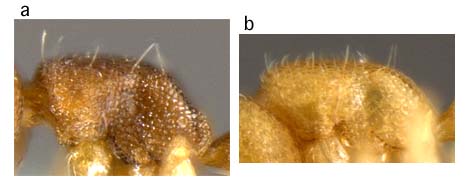| Genus List | Species List | Genus Overview |

10a. Antennae 11-segmented, large enough to count the seven segments between the two-segmented club and the larger first funicular segment; face reticulate rugose: 20
10b. Antennae 9-segmented, so small it is hard to count the five segments between the two-segmented club and the larger first funicular segment; face finely punctate: 30

20a. Pronotal dorsum shallowly reticulate, not longitudinally rugose; hind tibia with short appressed pubescence: brevipilosa
20b. Pronotal dorsum longitudinally rugose; hind tibia with longer suberect pilosity: urichi

30a. Mesosoma relatively elongate; propodeum with separate dorsal face rounding into posterior face: 35
30b. Mesosoma strongly ankylosed; propodeum short and sloping, without distinct dorsal face: 40

35a. Propodeal suture impressed; petiole with distinct acicular anteroventral tooth: JTL-002
35b. Propodeal suture not impressed; petiole lacking anteroventral tooth: JTL-007

40a. Mesosomal dorsum with about 4 pairs of erect setae, fourth abdominal tergite with abundant short erect setae; mesosomal and metasomal dorsa with underlying pubescence absent or so short and appressed as to be invisible; promesonotal dorsum finely longitudinally striate; color brown: reina
40b. Mesosomal and metasomal dorsa with abundant suberect pubescence, lacking erect setae or at lease these not clearly distinguishable from pubescence; promesonotal dorsum finely punctate, not striate; color yellow: inca
Page author:
John T. Longino, The Evergreen State College, Olympia WA 98505 USA.longinoj@evergreen.edu